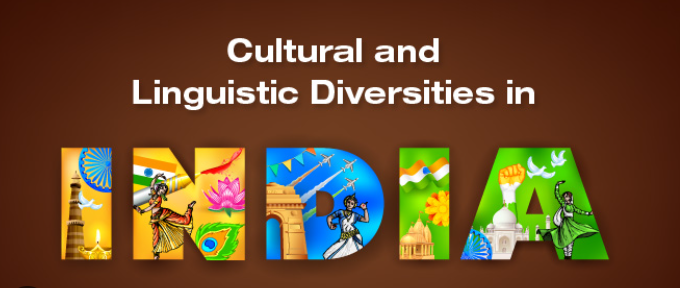India, with its multitude of languages and dialects, offers a vibrant tapestry of linguistic diversity that is richly reflected in its literature and media. This diversity not only enhances the cultural fabric of the nation but also provides a myriad of perspectives and voices. This article explores the significant role of linguistic diversity in Indian literature and media, highlighting its contributions to cultural and literary heritage.
1. Linguistic Landscape of India
1.1. Multilingual Society
Overview: India is home to a vast number of languages, making it one of the most linguistically diverse countries in the world.
Key Points:
- Constitutional Recognition: The Indian Constitution recognizes 22 scheduled languages.
- Diverse Dialects: Hundreds of dialects are spoken across the country, reflecting regional and cultural diversity.
Examples:
- Scheduled Languages: Hindi, Bengali, Tamil, Telugu, Marathi, Urdu, and others.
- Dialects: Varieties such as Bhojpuri, Marwari, and Awadhi within the Hindi-speaking region.
1.2. Language and Identity
Overview: Language is a crucial part of identity and cultural expression in India.

Key Points:
- Regional Identity: Languages often reflect regional identities and cultural heritage.
- Personal Identity: Individuals may identify with multiple languages, shaping their personal and cultural identities.
Examples:
- Regional: Tamil Nadu’s pride in the Tamil language and its literary tradition.
- Personal: A person in Maharashtra might speak Marathi at home, Hindi in public spaces, and English at work.
2. Linguistic Diversity in Indian Literature
2.1. Classical and Modern Literature
Overview: Indian literature spans classical and modern periods, with significant works in multiple languages.
Key Points:
- Classical Literature: Ancient texts in Sanskrit, Tamil, Kannada, Telugu, and other classical languages.
- Modern Literature: Contemporary works in both regional languages and English.
Examples:
- Classical Texts: The Ramayana and Mahabharata in Sanskrit, Sangam literature in Tamil.
- Modern Works: Rabindranath Tagore’s works in Bengali, R.K. Narayan’s novels in English.
2.2. Regional Literary Traditions
Overview: Each region in India has its own rich literary tradition, contributing to the national literary landscape.
Key Points:
- Regional Narratives: Stories and themes rooted in local cultures and experiences.
- Translation and Cross-Pollination: Many works are translated into other Indian languages and English, fostering cross-cultural understanding.
Examples:
- Bengali Literature: Works by authors like Rabindranath Tagore and Sarat Chandra Chattopadhyay.
- Marathi Literature: Contributions by authors like P.L. Deshpande and Vijay Tendulkar.
3. Linguistic Diversity in Indian Media
3.1. Print Media
Overview: Indian print media, including newspapers and magazines, is published in numerous languages.
Key Points:
- Regional Publications: Newspapers and magazines in regional languages cater to local audiences.
- National Reach: English-language publications have a wide national readership.
Examples:
- Regional Newspapers: “Anandabazar Patrika” in Bengali, “Dina Thanthi” in Tamil.
- National Newspapers: “The Times of India” in English, with regional editions in multiple languages.
3.2. Broadcast Media
Overview: Television and radio broadcast content in a variety of languages, reflecting India’s linguistic diversity.
Key Points:
- Regional Channels: Television channels in regional languages offer news, entertainment, and cultural programming.
- National Channels: National channels often broadcast in Hindi and English but may include regional language segments.
Examples:
- Regional TV: Sun TV in Tamil, Zee Marathi in Marathi.
- National TV: Doordarshan’s national broadcasts in Hindi and English, with regional language segments.
4. Digital Media and Linguistic Diversity
4.1. Online Platforms
Overview: The internet and social media platforms provide new avenues for linguistic expression and access to content in various languages.
Key Points:
- Language-Specific Content: Websites and social media platforms offer content in multiple languages.
- User-Generated Content: Individuals create and share content in their native languages, enhancing linguistic diversity online.
Examples:
- Language-Specific Websites: News and entertainment websites in languages like Hindi, Telugu, and Bengali.
- Social Media: Platforms like YouTube and Twitter hosting content in regional languages.
4.2. Digital Literature
Overview: Digital platforms have revolutionized access to literature, enabling authors to publish and readers to access works in various languages.
Key Points:
- E-Books and Online Journals: Availability of e-books and literary journals in multiple languages.
- Self-Publishing: Authors can self-publish their works in regional languages, reaching wider audiences.
Examples:
- E-Books: Digital versions of classic and contemporary works in languages like Malayalam, Kannada, and Punjabi.
- Online Journals: Literary magazines and journals publishing regional language content online.
5. Challenges and Opportunities
5.1. Preservation of Linguistic Heritage
Overview: Preserving linguistic heritage amid globalization and modernization is a key challenge.
Key Points:
- Endangered Languages: Efforts to document and revitalize endangered languages.
- Educational Initiatives: Promoting regional languages through education and media.
Examples:
- Documentation Projects: Initiatives to record and archive endangered languages like Tulu and Bodo.
- Language Education: Schools and universities offering courses in regional languages.
5.2. Promoting Linguistic Inclusivity
Overview: Ensuring linguistic inclusivity in literature and media is crucial for cultural representation and equity.
Key Points:
- Inclusive Policies: Media policies that support content creation in diverse languages.
- Access to Resources: Providing access to literary and media resources in multiple languages.
Examples:
- Media Policies: Government and private sector initiatives to support regional language media.
- Resource Access: Libraries and online platforms offering books and media in various languages.
Conclusion
The linguistic diversity of India is a cornerstone of its rich cultural and literary heritage. Indian literature and media, reflecting this diversity, offer a multitude of voices and perspectives. By embracing and promoting linguistic inclusivity, India can continue to celebrate its cultural mosaic, ensuring that all languages and their speakers are valued and represented.

